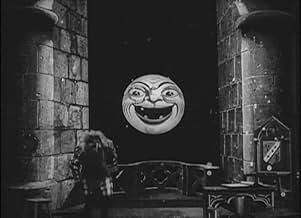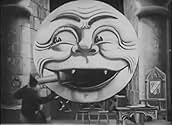NOTE IMDb
7,4/10
5,1 k
MA NOTE
Ajouter une intrigue dans votre langueAn astronomer falls asleep and has a strange dream involving a fairy queen and the Moon.An astronomer falls asleep and has a strange dream involving a fairy queen and the Moon.An astronomer falls asleep and has a strange dream involving a fairy queen and the Moon.
- Réalisation
- Scénario
- Casting principal
Jehanne d'Alcy
- Phoebe - la bonne fée
- (non crédité)
Georges Méliès
- L'astronome
- (non crédité)
Avis à la une
Fantastic short film from pioneering filmmaker Georges Méliès. A great companion piece to his later classic, A Trip to the Moon (1902). That name was also given to this one when released in the US. The original (and more fitting) name is The Astronomer's Dream. The story to this is an astronomer who looks like Merlin is visited by a woman and a demon and has dreams about the moon. The special effects and sets are really cool, especially when you consider this film's age. Méliès was ahead of his time in many ways. Definitely worth a look for anyone into film history or silent shorts or anyone with a few minutes to spare. I can't imagine anyone seeing this and regretting it. Well, a-holes maybe.
After I watched "La lune à un mètre", I read the summary for this short film on IMDB...and I must say that it explained a lot of what I just saw! Yes, the film is quite confusing and exactly WHAT is happening and WHY...well, they seem a bit illusive. Now none of this is to say this is a bad film. After all, it was made by the French master, Georges Méliès, and you know this means lots of trick photography and magical moments....and this one has plenty of them! So, instead of summarizing the film, I say just watch it and all the weirdness and just enjoy....it's clever, cute and much like so many of his other films, albeit the only one with a gigantic moon that eats telescopes!! Fun.
'The Astronomer's Dream (1898)' depicts a wacky nightmare than an astronomer has while gazing up at the moon. It involves devilish creatures, heavenly women and grotesque celestial bodies. It's explicitly framed as a dream (primarily via the title), so the piece doesn't have to make a lot of sense. That's good, because it doesn't. It operates on the sort of dream logic that sees ordinary activities morph into battles against otherworldly beings, sees regular objects take on a life of their own and pits a hopelessly logical protagonist against a hopelessly illogical situation. Making ample use of early special effects (mostly those achieved with a well-timed cut), the flick wonderfully achieves its goal of presenting a waking dream to its audience. It's short, sweet and visually impressive. It's still really good considering it came out 100 years before I was even born. 7/10.
Astronomer's Dream, The (1898)
*** (out of 4)
aka La Lune a un metre
An astronomer is in his office working when the devil and a woman appear to him and this sets off a strange dream, which includes the moon attacking him. This is another enjoyable film from Meiles as we get to see various magic tricks including the familiar gags of the astronomer going to sit down only to have the chair disappear. What really stands out in this film is the attack by the moon, which is perfectly done and leads to several laughs. I love Melies' design of the moon making it something to fear with its evil eyes and mouth. The special effects are quite nice throughout. This is certainly a good place for newbies to start.
*** (out of 4)
aka La Lune a un metre
An astronomer is in his office working when the devil and a woman appear to him and this sets off a strange dream, which includes the moon attacking him. This is another enjoyable film from Meiles as we get to see various magic tricks including the familiar gags of the astronomer going to sit down only to have the chair disappear. What really stands out in this film is the attack by the moon, which is perfectly done and leads to several laughs. I love Melies' design of the moon making it something to fear with its evil eyes and mouth. The special effects are quite nice throughout. This is certainly a good place for newbies to start.
This is actually a very elaborate fiction film for 1898. Made by Georges Méliès, it lasts over three minutes, when most films during the period lasted about a minute or less. Early cinema historian Frank Gray refers to this film as having consisted of three shots and 60 meters length. Yet, I can't precisely distinguish or separate shots or scenes in it, as the entire film takes place from a fixed framing and long-shot perspective. One could go to either extreme: saying that this is a single shot-scene film since its perspective is stationary, or you could say it consists of dozens of shots, including the trick splices for appearances, disappearances, substitutions and stop-motion animation, which is to say this film is a series of jump cuts.
"The Astronomer's Dream", however, does contain a three-part structure, I'd say. The bookend parts are of the astronomer safe within his laboratory, with the longer, middle part being the nightmare. There are also at least three slightly different decors used: the outer one with the telescope and the entire laboratory; a tighter, less furnished, yet similar one for closer views of the moon during the dream; and, briefly, a wall. Moreover, as indicated by this film having three entries in the Star catalogue, it was available to exhibitors in three parts, which was common then, as films were generally sold in 20-meter lengths. Regardless, this is a sophisticated narrative and production for its time.
The following year, Méliès would produce his first féerie film (fairy film), "Cinderella", which consists of at least four distinct scenes transitioned by dissolves. "Cinderella", albeit, is in the tableau, theatrical style of stationary shot-scenes, but it does distinguish spatially separate scenes for a more advanced narrative construction. One fiction film in 1898, Robert W. Paul's "Come Along Do!" also contained two spatially separate scenes with action continuing across them. "The Astronomer's Dream", however, was Méliès's then most elaborate and sophisticated dream or trick film, although it does contain a fairy godmother type in the goddess Phoebe, who protects the astronomer from attacks by demons, the moon and the rest of the nightmare. It's purely part of what Tom Gunning has referred to as "the cinema of attractions"; the attraction here being the magic or tricks accomplished mostly through substitution splices (a.k.a. stop substitutions), as well as theatrical props and transitions and a brief chalkboard animation within the scene. Today, these trick films hold up well and remain at least amusing because of Méliès's wacky and imaginative humor; their primitiveness is even part of their charm.
"The Astronomer's Dream", however, does contain a three-part structure, I'd say. The bookend parts are of the astronomer safe within his laboratory, with the longer, middle part being the nightmare. There are also at least three slightly different decors used: the outer one with the telescope and the entire laboratory; a tighter, less furnished, yet similar one for closer views of the moon during the dream; and, briefly, a wall. Moreover, as indicated by this film having three entries in the Star catalogue, it was available to exhibitors in three parts, which was common then, as films were generally sold in 20-meter lengths. Regardless, this is a sophisticated narrative and production for its time.
The following year, Méliès would produce his first féerie film (fairy film), "Cinderella", which consists of at least four distinct scenes transitioned by dissolves. "Cinderella", albeit, is in the tableau, theatrical style of stationary shot-scenes, but it does distinguish spatially separate scenes for a more advanced narrative construction. One fiction film in 1898, Robert W. Paul's "Come Along Do!" also contained two spatially separate scenes with action continuing across them. "The Astronomer's Dream", however, was Méliès's then most elaborate and sophisticated dream or trick film, although it does contain a fairy godmother type in the goddess Phoebe, who protects the astronomer from attacks by demons, the moon and the rest of the nightmare. It's purely part of what Tom Gunning has referred to as "the cinema of attractions"; the attraction here being the magic or tricks accomplished mostly through substitution splices (a.k.a. stop substitutions), as well as theatrical props and transitions and a brief chalkboard animation within the scene. Today, these trick films hold up well and remain at least amusing because of Méliès's wacky and imaginative humor; their primitiveness is even part of their charm.
Le saviez-vous
- AnecdotesWhen this film was imported into the United States by producer Sigmund Lubin in 1899 he re-titled it A Trip to the Moon. However this has no relation to the 1902 film A Trip to the Moon. The original translated title is "The Moon at One Meter's Distance" or freely "The Moon at Arm's Length".
- ConnexionsFeatured in Castle: Punked (2010)
Meilleurs choix
Connectez-vous pour évaluer et suivre la liste de favoris afin de recevoir des recommandations personnalisées
Détails
- Date de sortie
- Pays d’origine
- Langue
- Aussi connu sous le nom de
- La lune à un mètre. L'observatoire, la lune, Phoebé
- Lieux de tournage
- Sociétés de production
- Voir plus de crédits d'entreprise sur IMDbPro
- Durée
- 3min
- Couleur
- Mixage
- Rapport de forme
- 1.33 : 1
Contribuer à cette page
Suggérer une modification ou ajouter du contenu manquant




















